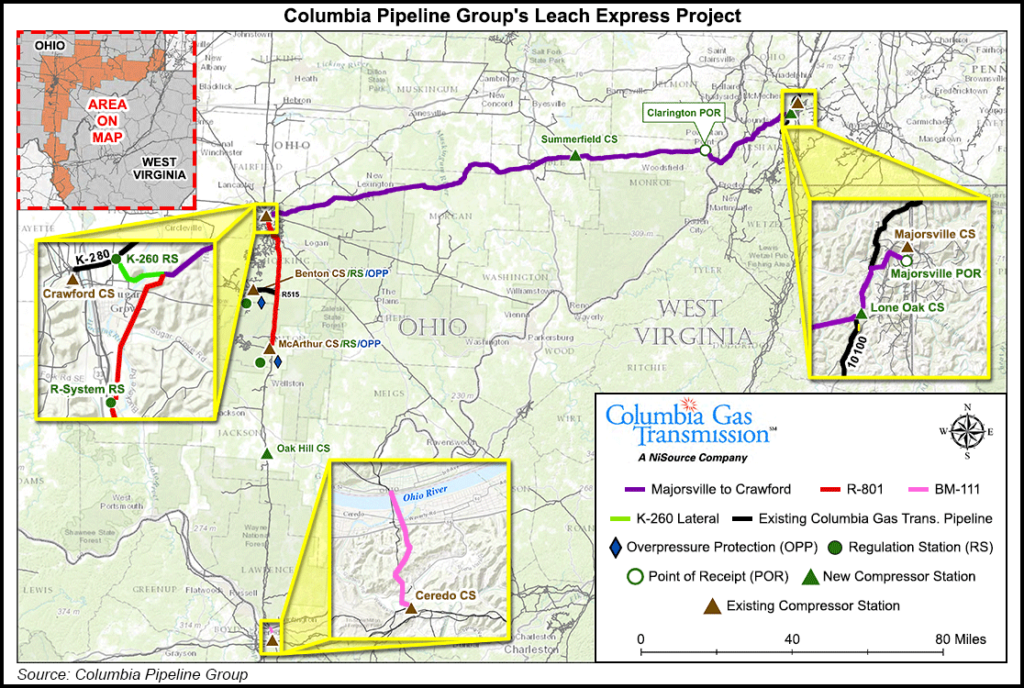Regulatory | Infrastructure | NGI All News Access | NGI The Weekly Gas Market Report
The FERC Strikes Back; Press Release Excessively Details Environmental Processing
In an unusual move Thursday, FERC issued a lengthy press release laying out in exceptionally extensive detail all of its actions, investigations and consultations in its preparation of draft environmental impact statements (DEIS) issued for Columbia Pipeline Group’s Leach XPress and Rayne XPress expansion projects.

FERC’s press statement includes a series of links to documents in the DEIS, including 18 appendices — 862 pages in all.
The press release was obviously directed at the multitude of attacks by climate change enthusiasts, who in the last year have switched much of their ire against fossil fuels from attempts to stop shale fracturing at the wellhead to slowing or derailing new natural gas pipeline and liquefied natural gas (LNG) projects.
The Federal Energy Regulatory Commission has become a target, with protesters attempting to upset Commission meetings and filing lawsuits charging the agency fails to do a thorough job in its environmental reviews. The Sierra Club and others have lost several lawsuits attempting to overturn FERC authorization of the Dominion Cove Point export LNG terminal in Maryland, which is now under construction (see Daily GPI, June 3, 2015)
Thousands of letters of protest have rained down on FERC over the last few years, objecting to every pipeline and LNG project. Earlier this year a group of 165 protest groups of various stripes sent a letter to lawmakers asking them to request the Government Accountability Office to launch an investigation of FERC, which they claim is biased against pipelines (see Daily GPI, Jan. 19). In one lawsuit filed in federal court, environmental group Delaware Riverkeeper Network argued that FERC is “biased toward approving jurisdictional natural gas pipeline projects” because of its funding structure (see Daily GPI, March 4).
In what has become a routine occurrence, FERC’s open meeting Thursday was interrupted by protesters who shouted allegations that the agency routinely gives rubber stamp approval to projects the protesters believe will damage the environment, before they were escorted from the room. In December, FERC members testifying before a House subcommittee said increased opposition to energy infrastructure projects threatens to further impede their development (see Daily GPI, Dec. 1, 2015).
The Leach XPress and Rayne XPress expansions are important projects, but they are not major long line pipelines. One of them is simply addition of compression. Generally FERC issues detailed environmental statements for all projects which are available to the public under the project docket number on the Commission website. It does not normally issue a detailed press release or any press release at all.
In this case “FERC staff determined that construction and operation of the projects would result in limited adverse environmental impacts, with the exception of impacts on forested land,” according to the DEIS. “Construction of Columbia Gas’s Leach XPress Project would result in significant impacts on forested lands,” but because of “Columbia Gas’ proposed mitigation and to recommendations in the draft EIS. FERC staff concludes that the impacts on forested lands would be reduced to less than significant levels.”
The related projects were announced by the Columbia Pipeline Group in 2014 (see Shale Daily, Aug. 12, 2014). Columbia Gas applied at the Federal Energy Regulatory Commission for a certificate for its Leach XPress, which would add up to 1.53 million Dth/d of capacity to “more liquid markets” for gas from Appalachia, last June (see Daily GPI, June 8, 2015). Columbia Gulf filed for Rayne XPress six weeks later.
Rayne is designed to expand the capacity of Columbia Gulf’s existing mainline to transport up to an additional 621,000 Dth/d of in a north-to-south direction and ensure that firm, contractual obligations are maintained for existing customers served from Columbia Gulf’s mainline, the pipeline told FERC (see Daily GPI, Aug. 13, 2015).
The Leach XPress project would include a total of approximately 161 miles of new 20- to 36-inch-diameter pipeline, three new compressor stations and modifications at two existing compressor stations [CP15-514]. It would also include the abandonment in place of 28 miles of a existing 20-inch-diameter natural gas pipeline beginning at the Crawford compressor station in Fairfield County, OH and traversing south to Hocking County, OH before terminating at the McArthur regulator station in Vinton County, OH.
The Rayne XPress Expansion project would involve the construction and operation of new compressor stations in Carter, Menifee and Montgomery counties in Kentucky, and modification of an existing station in Montgomery County [CP15-539].
FERC will accept comments on the DEIS through June 13.
© 2024 Natural Gas Intelligence. All rights reserved.
ISSN © 1532-1231 | ISSN © 2577-9877 | ISSN © 1532-1266 |
